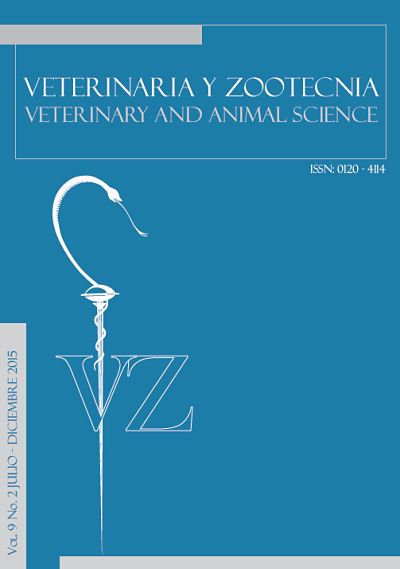Authors
Abstract
The inclusion of whole orange fruit silage in 26 bovine females F1 (Holstein x Zebu) 8 years old average, 508kg of body weight, five births and 184 days of lactation, was evaluated during an experimental period of 28 days (7 for adaptation and 21 for sampling), divided into two groups randomly: the H0 control group (n=13) underwent conventional food from the farm and the H1 group (n=13) for which 30% of commercial concentrate was replaced for the same amount of orange silage MS (35kg). Production changes, percent of total solids, crude protein, total fat, and pH, acidity of milk and ruminal pH were evaluated. The data were subjected to variance analysis (ANOVA model type III) in the statistical package R® resulting in multiple comparisons of least squares means for which the Tukey-Kramer test was used. Results showed a highly significant difference between treatments for milk yield (P<0,001) showing a decrease of 20.5%. an average and mean standard error (PE) of (7,838±0,339L) for the H0 group and of (6,229±0,342L) for the H1 group. The total solids differed significantly between treatments (P<0,0180) with a PE (11,011±0,361) and (12,266±0,361) for the group H0 and H1 respectively, achieving an 11,4% correction. Significant changes between treatments (P<0.0189) were evident and highly significant changes between moments (P<0.0001) for milk pH were shown. Furthermore, highly significant variability was evident between moments for crude protein (P<0,0180) and milk acidity (P<0,0004). Despite the variations found, the results of this study indicate that whole oranges silage is a viable option for cattle feed and animal performance.
References
Alais, Ch.; Godina, A.L. Ciencia de la leche, principios de técnica lechera. 4ª. Ed. Paris: Sociètè d’Edition et de promotion Agro-Alimentaires, Industrielles, et Comerciales, 1985. 861p.
Arthington, J.D.; Kunkle, W.E.; Martin, A.M. Citrus pulp for cattle. Veterinary Clinics of North America. Food Animal Practice, v. 18, n. 2, p. 317-326, 2002.
Assis, A.J. et al. Polpa cítrica em dietas de vacas em lactação. Digestibilidade dos nutrientes em dois períodos de coleta de fezes, pH e nitrogênio amoniacal do líquido ruminal. Revista Brasileira de Zootecnia, v. 18, n.1, p. 251-257, 2004.
AOAC. Official methods of analysis. 19th. Ed. Maryland: AOAC international, 2012.
Bampidis, V.A.; Robinson, P.H. Citrus by-products as ruminant feeds: A review.Animal Feed Science and Technology, v. 128, n. 3, p. 175-217, 2006.
Belibasakis, N.G.; Tsirgogianni, D. Effects of dried citrus pulp on milk yield, milk composition and blood components of dairy cows. Animal Feed Science and Technology, v. 60, n.1, p. 87-92, 1996.
Benítez, S.Y.; Poveda, C.A. Evaluación nutricional de ensilajes con diferentes niveles de inclusión de cáscara de naranja (Citrus sinensis) y digestibilidad in vivo como alternativa energética para alimentación de cerdos. Revista Colombiana de Ciencia Animal, v.4, n. 1, p. 20-28, 2011.
Caparra, P. et al. Solar-dried citrus pulp as an alternative energy source in lamb diets: Effects on growth and carcass and meat quality. Small Ruminant Research, v.68, n.3, p. 303-311,
2007.
FAO. Milk testing and Quality Control. Milk Processing Guide Series. Department of Dairy Science. Gainesville: University of Florida, 2000.
Fox, P.F.; McSweeney, P.L. Dairy chemistry and biochemistry. New York: Springer Science & Business Media, 2015.
Grasser, L.A. et al. Quantity and economic importance of nine selected by-products used in California dairy rations. Journal Dairy Science, v.78, n.4, p.962-971, 1995.
Leiva, E.; Hall, B.M.; Van Horn, H.H. Performance of dairy cattle fed citrus pulp or corn products as sources of neutral detergent-soluble carbohydrates. Journal Dairy Science, v. 83, n.12, p. 2866-2875, 2000.
Martínez, M.J. et al. Características nutritivas de los hollejos húmedos de naranja (Citrus sinensis cv. Valencia) mantenidos en estibas. Téc Pecu-México, v.46, n.2, p.183-193, 2008.
Ministerio de la Protección Social. Decreto 616 de 2006. Bogotá: Diario Oficial, 2006 NRC. Nutrient requirements of dairy cattle. 6th. Ed. Washington: National Academy of sciences Press, 1978.
Pássaro, C.; Navarro, P.; Salvador, A. Poscosecha. In: Garcés, L.F. (Ed.). Cítricos: cultivo, cosecha e industrialización. Caldas: Corporación Universitaria Lasallista, 2012. p. 223-284.
Piquer, O. et al. Whole citrus fruits as an alternative to wheat grain or citrus pulp in sheep diet: Effect on the evolution of ruminal parameters. Small Ruminant Research, v. 83, n. 1, p. 14-21, 2009.
Rivera, B. et al. Propuesta para la clasificación de sistemas de producción de leche: el caso de la zona de influencia de Manizales. Revista Departamento de Sistemas de Producción, v. 10,
n.1, p. 83-103, 1999.
Román, S.; Guerrero, L.; Pacheco, L. Evaluación de la calidad fisicoquímica, higiénica y sanitaria de la leche cruda almacenada en frío. Revista Científica, v.13, n.2, p. 146- 152, 2003.
Santiago, M.G. Manual de normas de control de calidad de leche cruda. Ciudad de México: Secretaría de Desarrollo Social (SEDESOL), 2007.
Solomon, R. et al. The effect of nonstructural carbohydrate and addition of full fat extruded soybeans on the concentration of conjugated linoleic acid in the milk fat of dairy cows.
Journal Dairy Science, v. 83, n.6, p. 1322-1329, 2000.
Strobel, H.J.; Russell, J.B. Effect of pH and energy spilling on bacterial protein synthesis by carbohydrate-limited cultures of mixed rumen bacteria. Journal of Dairy Science, v.69, n. 11, p. 2941-2947, 1986.
Villareal, M. et al. Effect of supplementation with pelleted citrus pulp on digestibility and intake in beef cattle fed a tropical grass-based diet (Cynodon nlemfuensis).Animal Feed Science and Technology, v.125, p.163-173, 2006.
Volanis, M. et al. Utilization of an ensiled citrus pulp mixture in the feeding of lactating dairy ewes. Small Ruminant Research, v. 64, n.1, p. 190-195, 2006.
Volanis, M.; Zoiopoulos, P.; Tzerakis, K. Effects of feeding ensiled sliced oranges to lactating dairy sheep. Small Ruminant Research, v. 53, n.1, p.15-21, 2004.
Wing, J.M.; editor. Citrus feed stuffs for dairy cattle. Gainesville: University of Florida, 1982.

 pdf (Español (España))
pdf (Español (España))
 FLIP
FLIP














